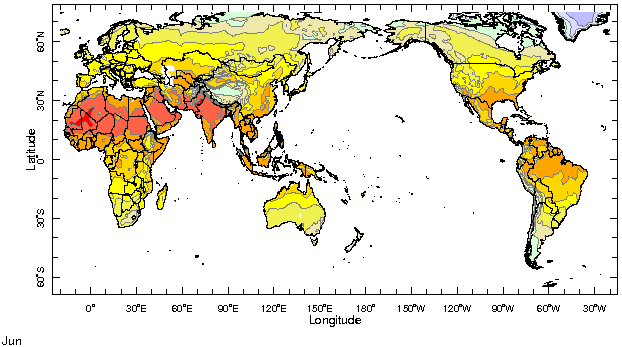|
IRI Climate Digest
July 2006
June Global Climate Summary
Climatological Background
In June, the sun's maximum northward location is achieved at 23.6 degrees north. Surface heating of the continents has initiated summer monsoonal systems or northern hemisphere warm season rains. In the southern hemisphere, winter is setting in with fewer daylight hours and cooler temperatures. The southern parts of South Africa, Australia, and South America are now in the path of mid latitude storm tracks.
Monthly Mean Temperature (1961-1990), data from the Climate Research
Unit, University of East Anglia


Monthly Mean Precipitation (1961-1990), data from the Climate Research
Unit, University of East Anglia


Temperatures
Warmer-than-normal temperatures dominated the northern hemisphere, spreading from the high latitudes of Eurasia and North America, to the mid-latitudes of western Europe and central southwest Asia, to the low latitudes of Africa. In the southern hemisphere, temperatures were above normal in most of South America, while in Australia colder-than-average conditions persisted, in some parts for the third month in a row (Temperature Persistence Map). South and Southeast Asia, and southern and eastern Africa witnessed near-normal conditions.
Temperature Difference from the 1961-1990 mean, with data
from NCEP Climate Prediction Center, CAMS.


Precipitation
In June, while wetter-than-average conditions prevailed in the equatorial Indian Ocean and in the western Pacific warm pool/Maritime Continent region, the start of the northern hemisphere monsoon season was deficient in large swaths of West Africa and the Indian subcontinent. Record-breaking wet conditions were observed along the Atlantic Coast of the United States. Wetter-than-average conditions were also observed in the Lesser Antilles of the eastern Caribbean, and in northeastern and southeastern provinces of China, while drier-than-average conditions characterized northern and western Europe.
Precipitation Difference from 1979-2000 mean, with data
from NCEP Climate Prediction Center, CAMS-OPI.


Oceanic Conditions
Warm SST anomalies dominated the equatorial latitudes of the Indian, western Pacific, and Atlantic basins. In the latter, conspicuous warm anomalies were observed along the west coast of Africa, in the pattern characteristic of the Atlantic "El Niņo". All ocean basins were also warmer than average at subtropical latitudes of the southern hemisphere, in contrast to the cooler-than-average temperatures at poleward latitudes around Antarctica. Warmer-than-average conditions characterized most of the North Atlantic basin, including the North Sea and Mediterranean Sea.
Monthly Sea Surface Temperature Difference from the 1971-2000 mean,
with data from the Environmental Modeling Center, NCEP/NOAA.


Contents |
Special |
Impacts |
Climate |
Forecast
|

